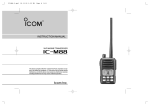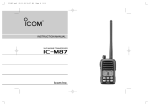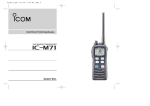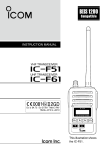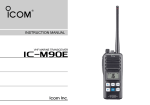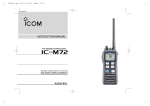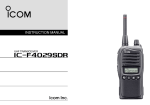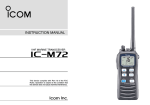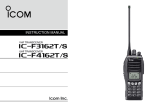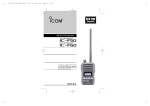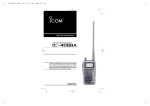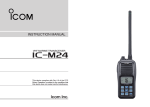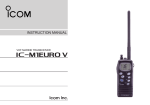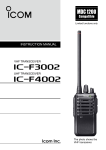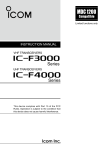Download IC-M87 (ATEX) Instruction Manual
Transcript
INSTRUCTION MANUAL VHF MARINE TRANSCEIVER iM87 IN CASE OF EMERGENCY RECOMMENDATION If your vessel requires assistance, contact other vessels and the Coast Guard by sending a distress call on Channel 16. CLEAN THE TRANSCEIVER THOROUGHLY WITH FRESH WATER after exposure to saltwater. Otherwise, the transceiver’s keys, switches and controllers may become inoperable due to salt crystallization. ❍ USING CHANNEL 16 DISTRESS CALL PROCEDURE 1. “MAYDAY MAYDAY MAYDAY.” 2. “THIS IS ���������������������������” (name of vessel) 3. Your call sign or other indication of the vessel. 4. “LOCATED AT ��������������������� ” (your position) 5. The nature of the distress and assistance required. 6. A ny other information which might facilitate the rescue. i NOTE: DO NOT wash the transceiver in water if there is any reason to suspect the waterproofing may not be effective. For example, in cases where the battery pack rubber seal is damaged, the transceiver/battery pack is cracked or broken, or has been dropped, or when the battery pack is detached from the transceiver. FOREWORD FEATURES Thank you for purchasing this Icom product. The IC-M87 VHF MARINE TRANSCEIVER is designed and built with Icom’s state of the art technology and craftsmanship. With proper care this product should provide you with years of trouble-free operation. ☞ 22 free channels for PMR use IMPORTANT carefully and com- pletely before using the transceiver. SAVE THIS INSTRUCTION MANUAL—This instruction manual contains important operating instructions for the IC-M87. EXPLICIT DEFINITIONS WORD DEFINITION RDANGER! Personal death, serious injury or an explosion may occur. RWARNING! Personal injury, fire hazard or electric shock may occur. NOTE *Appropriate license will be required. ☞ Tough waterproof construction READ ALL INSTRUCTIONS CAUTION The IC-M87 has 22 free channels reserved for PMR use (146–174MHz). Wide/narrow channel spacing is programmable for each channel, and CTCSS and DTCS signaling is included. The IC-M87 is built tough to withstand hazardous and unhospitable environments at sea and on land. Even if the IC-M87 is dropped into water, it’s waterproofing* will protect it from harm. The compact and durable body meets the military specifications (MIL-STD). * Equivalent to JIS waterproof grade 7 or IPX7 of the corresponding International Standard IEC 529 (1989). (1m depth for 30 minutes) ☞ Simple operation 6 clearly labelled buttons on the front panel and the volume/power knob maximize simplicity of operation. Even when wearing gloves, the large buttons are easy to operate. A large, clear LCD with backlighting and backlit buttons make night time operation simple. Equipment damage may occur. If disregarded, inconvenience only. No risk of personal injury, fire or electric shock. ii PRECAUTIONS RDANGER! Use and charge only specified Icom battery packs with Icom radios or Icom chargers. Only Icom battery packs are tested and approved for use with Icom radios or charged with Icom chargers. Using third-party or counterfeit battery packs or chargers may cause smoke, fire, or cause the battery to burst. RWARNING! NEVER connect the transceiver to an AC outlet. This may pose a fire hazard or result in an electric shock. RWARNING! NEVER hold the transceiver so that the antenna is very close to, or touching exposed parts of the body, especially the face or eyes, while transmitting. The transceiver will perform best if the microphone is 5 to 10 cm away from the lips and the transceiver is vertical. CAUTION: NEVER connect the transceiver to a power source other than the BP-227AX. Such a connection will ruin the transceiver. KEEP the transceiver at least 0.9 meter away from your vessel’s magnetic navigation compass. BE CAREFUL! The transceiver meets IPX7* requirements for waterproof protection. However, once the transceiver has been dropped, waterproof protection cannot be guaranteed because of possible damage to the transceiver's case or the waterproof seal. * Only when the BP-227AX, flexible antenna, [SP MIC] jack cover is attached. MAKE SURE the flexible antenna and battery pack are securely attached to the transceiver, and that the antenna and battery pack are dry before attachment. Exposing the inside of the transceiver to water will result in serious damage to the transceiver. After exposure to water, clean the battery contacts thoroughly with fresh water and dry them completely to remove any water or salt residue. DO NOT use or place the transceiver in direct sunlight or in areas with temperatures below –15°C or above +55°C: Marine, below –25°C or above +55°C: PMR. KEEP the transceiver out of the reach of children. iii Icom, Icom Inc. and Icom logo are registered trademarks of Icom Incorporated (Japan) in Japan, the United States, United Kingdom, Germany, France, Spain, Russia and/or other countries. TABLE OF CONTENTS IN CASE OF EMERGENCY................................................... i RECOMMENDATION............................................................. i FOREWORD......................................................................... ii IMPORTANT.......................................................................... ii EXPLICIT DEFINITIONS....................................................... ii FEATURES............................................................................ ii PRECAUTIONS.................................................................... iii TABLE OF CONTENTS........................................................ iv INTRINSIC SAFETY.............................................................. v 1 OPERATING RULES........................................................1 2 SUPPLIED ACCESSORIES AND ATTACHMENTS.........2 3 PANEL DESCRIPTION.................................................4–7 ■ Front, top and side panels.............................................4 ■ Function display............................................................6 6 DUALWATCH/TRI-WATCH.............................................15 ■ Description..................................................................15 ■ Operation....................................................................15 7 LAND (PMR) CHANNEL OPERATION..........................16 ■ LAND (PMR) Channel Group.....................................16 ■ Function display..........................................................16 8 SET MODE...............................................................17–21 ■ Set mode programming...............................................17 ■ Set mode items...........................................................18 9 BATTERY CHARGING.............................................22–25 ■ Battery charging..........................................................22 ■ Cautions......................................................................22 ■ AD-100 installation......................................................24 ■ Optional battery chargers............................................25 4 BASIC OPERATION...................................................8–12 ■ Channel selection..........................................................8 ■ Receiving and transmitting..........................................10 ■ Adjusting the squelch level..........................................11 ■ Automatic backlighting................................................11 ■ Lock function...............................................................11 ■ Call channel programming..........................................12 ■ Voice scrambler operation...........................................12 10SPEAKER-MICROPHONE.............................................26 ■ HM-138 Description....................................................26 ■ Attachments................................................................26 5 SCAN OPERATION..................................................13–14 ■ Scan types..................................................................13 ■ Setting TAG channels..................................................14 ■ Starting a scan............................................................14 15QUICK REFERENCE.....................................................31 11TROUBLESHOOTING....................................................27 12VHF MARINE CHANNEL LIST......................................28 13SPECIFICATIONS..........................................................29 14OPTIONS........................................................................30 16DOC................................................................................32 17ATEX CAUTIONS...........................................................33 iv INTRINSIC SAFETY Versions of the IC-M87 which display the “EX” marking on the serial number seal. The approval rating for these models is II2G Ex ib IIA T3. The ATEX standard is described on the 94/9/EC sticker (Ex Marking) and BP-227AX as below. WARNING! NEVER charge the BP-227AX (with/without the transceiver) in an explosive atmosphere. The optional battery chargers are not approved as Intrinsically Safe. When the transceiver is used in a hazardous area, the BP-227AX MUST be attached, either the jack cover or HM138 MUST be attached to the speaker-microphone connector. KEEP the transceiver and the BP-227AX clean to avoid any risk of ignition due to the build-up of electrostatic charges. Repair of Icom radios should only be carried out by authorized Icom distributors. In particular, repair of ATEX approved radios can ONLY be done by Icom to maintain the intrinsically safe rating. NEVER attempt to repair an ATEX approved radio. Only Icom has the repair expertise and procedures to maintain the ATEX approval. Contact your Icom distributor or authorised dealer for details. v BP-227AX • DO NOT OPEN WHEN AN EXPLOSIVE ATMOSPHERE MAY BE PRESENT. • DO NOT CHARGE THE BATTERY IN HAZARDOUS LOCATION. OPERATING RULES D Priorities • Read all rules and regulations pertaining to priorities and keep an up-to-date copy handy. Safety and distress calls take priority over all others. • You must monitor Channel 16 when you are not operating on another channel. • False or fraudulent distress calls are prohibited under law. D Privacy • Information overheard but not intended for you cannot lawfully be used in any way. • Indecent or profane language is prohibited. D Radio licenses (1) SHIP STATION LICENSE When your craft is equipped with a VHF FM transceiver, you must have a current radio station license before using the transceiver. It is unlawful to operate a ship station which is not licensed. 1 (2) OPERATOR’S LICENSE A restricted Radiotelephone Operator Permit is the license most often held by small vessel radio operators when a radio is not required for safety purposes. The Restricted Radiotelephone Operator Permit must be posted near the transceiver or be kept with the operator. Only a licensed radio operator may operate a transceiver. However, non-licensed individuals may talk over a transceiver if a licensed operator starts, supervises, ends the call and makes the necessary log entries. A current copy of the applicable government rules and regulations is only required to be on hand for vessels in which a radio telephone is compulsory. However, even if you are not required to have these on hand it is your responsibility to be thoroughly acquainted with all pertinent rules and regulations. Inquire through your dealer or the appropriate government agency for a Ship-Radiotelephone license. This license includes the call sign which is your craft’s identification for radio purposes. 1 2 SUPPLIED ACCESSORIES AND ATTACHMENTS D Supplied accessories The following accessories are supplied: Qty. • Swivel belt clip . . . . . . . . . . . . . . . . . . . . . . . . . . . . . . . . . . 1 • Stopper for the swivel belt clip . . . . . . . . . . . . . . . . . . . . . . 1 • Screws for the swivel belt clip . . . . . . . . . . . . . . . . . . . . . . 2 • Flexible antenna . . . . . . . . . . . . . . . . . . . . . . . . . . . . . . . . 1 • Handstrap . . . . . . . . . . . . . . . . . . . . . . . . . . . . . . . . . . . . . 1 • Battery pack . . . . . . . . . . . . . . . . . . . . . . . . . . . . . . . . . . . 1 • AC adapter* . . . . . . . . . . . . . . . . . . . . . . . . . . . . . . . . . . . . 1 • Battery charger . . . . . . . . . . . . . . . . . . . . . . . . . . . . . . . . . 1 w Clip the belt clip to a part of your belt and insert the stopper to the belt clip. *Not supplied with some version D Swivel belt clip To attach: q Attach the stopper to the back of the transceiver. Supplied screws Stopper 2 e Once the transceiver is locked in place, it will swivel 360 degrees. SUPPLIED ACCESSORIES AND ATTACHMENTS To remove: Turn the transceiver upside down, and then lift up to release the transceiver from the belt clip. 2 D Flexible antenna Connect the supplied flexible antenna to the antenna connector. CAUTION: • NEVER carry the transceiver by holding the antenna. • Transmitting without an antenna may damage the transceiver. D Handstrap Pass the handstrap through the loop on the back side of the transceiver as illustrated at right. This facilitates carrying. CAUTION: HOLD THE TRANSCEIVER TIGHTLY, WHEN ATTACHING OR REMOVING THE TRANSCEIVER FROM THE BELT CLIP. If the transceiver is accidentally dropped and the swivel belt clip’s stopper is scratched or damaged, the swivel belt clip may not work properly. 3 3 PANEL DESCRIPTION ■ Front, top and side panels q q VOLUME CONTROL [VOL] Turns power ON and adjusts the audio level. w ANTENNA CONNECTOR (p. 3) Connects the supplied antenna. w e SPEAKER-MICROPHONE CONNECTOR [SP MIC] (p. 26) Connects the optional speaker-microphone. [SP MIC] jack cover !0 e o r SCAN [SCN•DUAL] • Starts and stops normal or priority scan. (p. 14) • Enters watch mode when pushed for 1 sec. (p. 15) i r u NOTE: KEEP the [SP MIC] jack cover attached to the transceiver when the speakermicrophone is not in use. t y t TRANSMIT POWER/LOCK SWITCH [H/L•LOCK] • Selects high, middle (except for the German version) or low power when pushed. (p. 10) • Toggles the lock function ON/OFF when pushed for 1 sec. (p. 11) y CHANNEL 16 SWITCH [16•C] • Selects Channel 16 when pushed. (p. 8) • Selects the call channel when pushed for 1 sec. (p. 8) • Enters call channel write mode when the call channel is selected and this switch is pushed for 3 sec. (p. 12) 4 PANEL DESCRIPTION u CHANNEL UP/DOWN SWITCHES [Y]/[Z] •S elect an operating channel. (p. 9) •S elects the set mode condition of item. (p. 17) •C hecks TAG channels or changes scanning direction during scan. (p. 14) •S ets and clears the displayed channel as a TAG (scanned) channel when pushed both switches for 1 sec. • While turning power ON, clears all TAG channels in the selected channel group when both switches are pushed. i DIAL/CHANNEL GROUP SWITCH [DIAL] •S elects one of 3 regular channels in sequence when pushed for 1 sec. (pgs. 8, 9, 16) - International, USA (or ATIS*) and LAND (PMR) channels are available. *German version only 3 ï BATTERY PACK RELEASE BUTTON To release the battery pack: Push the battery release button in the direction of the arrow (q) as shown below. The battery pack is then released. To attach the battery pack: Slide the battery pack on the back of the transceiver in the direction of the arrow (w), then lock it with the battery release button. *Slide the battery pack until the battery release button makes a ‘click’ sound. Battery pack w • Push to return to the condition before selecting the channel when the priority channel or the call channel is selected. o SQUELCH SWITCH [SQL] (p. 11) • Push this switch, then set the squelch level with [Y]/[Z]. • Manually opens the squelch for channel monitoring while pushed and held. • While pushing this switch, turn the power ON to enter the set mode. !0 PTT SWITCH [PTT] Push and hold to transmit; release to receive. q Battery release button CAUTION: When pushing the battery release button, slide the battery pack slightly in the direction of the arrow (w) to ease release. This will prevent possible injuring to your fingers or nails 5 3 PANEL DESCRIPTION ■ Function display q w e r t y eTAG CHANNEL INDICATOR (p. 14) Appears when a TAG channel is selected. u rSCAN INDICATOR (p. 14) Blinks while scanning. !5 i o !0 !4 !3 !2 !1 qTRANSMIT INDICATOR (p. 10) Appears while transmitting. wBUSY INDICATOR (p. 10) • Appears when receiving a signal or when the squelch opens. • Blinks while monitoring. 6 tLOCK INDICATOR (p. 11) Appears while the lock function is activated. yNARROW INDICATOR (p. 16) Appears when narrow channel spacing is selected. *LAND (PMR) channel group only. uBATTERY INDICATOR Indicates remaining battery power. Indication Battery level Full Middle Charging Discharged required blinks when the battery is over charged. PANEL DESCRIPTION iDUALWATCH/TRI-WATCH INDICATORS (p. 15) “DUAL” appears during Dualwatch; “TRI” appears during Tri-watch. o SCRAMBLER INDICATOR Appears when the optional voice scrambler is activated. (pgs. 12, 21) !0DUPLEX INDICATOR Appears when a duplex channel is selected. !1SUB CHANNEL READOUT • Indicates Channel 16 during priority scan, Dualwatch or Tri-watch. (p. 15) • Indicates the set mode item while in set mode. 3 !4CHANNEL GROUP INDICATOR (pgs. 9, 16) “I” appears when International; “U” appears when U.S.A. (U.K. version only); “ ” appears when LAND (PMR) channel group is selected. “ATIS” appears when the channel group in which ATIS function is activated. (German version only) !5TRANSMIT POWER INDICATOR (p. 10) • “LOW” appears when low power is selected. • “MID” appears when middle power is selected. (Except for the German version) • No indication when high power is selected. !2CHANNEL NUMBER READOUT • Indicates the selected operating channel number. • In set mode, indicates the selected condition. !3CALL CHANNEL INDICATOR (p. 8) Appears when the call channel is selected. 7 4 BASIC OPERATION ■ Channel selection IMPORTANT: Prior to using the transceiver for the first time, the battery pack must be fully charged for optimum life and operation. To avoid damage to the transceiver, turn the power OFF while charging. D Channel 16 Channel 16 (Distress channel) is used for establishing initial contact with another station and for emergency communications. Channel 16 is automatically monitored during both Dualwatch and Tri-watch. While standing by, you must monitor Channel 16. q Push [16•C] to select Channel 16. wP ush [DIAL] to return to the condition before selecting Channel 16, or push [Y]/[Z] to select the operating channel. D Call channel Each regular channel group has a separate call channel. In addition, each call channel is monitored during Tri-watch. The call channels can be reprogrammed and are used to store your most often used channels in each channel group for quick recall. q Push [16•C] for 1 sec. to select the call channel in the selected channel group. • “CALL” and the call channel number appear. •E ach channel group may have its own call channel after programming a call channel. See the “Call channel programming” on p. 12 for details. w Push [DIAL] to return to the condition before selecting the call channel, or push [Y]/[Z] to select the operating channel. C C Push Push for 1 sec. hannel 16 is the default setting. C (depending on version) 8 BASIC OPERATION 4 D International, U.S.A and ATIS* channels There are 57 International, 58 U.S.A. and 57 ATIS* channels. These channel groups may be specified for the operating area. q Push [DIAL] to select a regular channel. w Push [Y]/[Z] to select a channel. Push International channels Push • “DUP” appears for duplex channels. e To change the channel group, push [DIAL] for 1 sec. • International, U.S.A. and ATIS* channels can be selected in sequence. Depending on the setting, LAND (PMR) channel can be selected. See the “LAND (PMR) CHANNEL OPERATION” on p. 16 for details. for 1 sec. for 1 sec. * German version only U.S.A channels ATIS channels* 9 4 BASIC OPERATION ■ Receiving and transmitting CAUTION: Transmitting without an antenna may damage the transceiver. qRotate [VOL] clockwise to turn power ON. wPush [SQL] to enter the squelch adjustment mode, then push [Y]/[Z] to set the squelch level. ePush and hold [SQL] for 1 sec. to open the squelch, then rotate [VOL] to set the volume level while holding down the [SQL] key. (See the set mode item “Monitor switch action” on p. 19.) rPush [Y]/[Z] to select the desired channel. - When receiving a signal, “ ” appears and audio is emitted from the speaker. - Further adjustment of [VOL] may be necessary at this point. tPush [H/L•LOCK] to select the output power if necessary. - “LOW” appears when low power is selected; “MID” appears when middle power is selected (except for the German version); no indication when high power is selected. - Choose low power for short range communications, choose high power for longer distance communications. - Some channels are for low power only. yPush and hold [PTT] to transmit, then speak into the microphone. - “TX” appears. - Channel 70 cannot be used for transmission (for GMDSS use). uRelease [PTT] to receive. 10 IMPORTANT: To maximize the readability of your transmitted signal, pause a few sec. after pushing [PTT], hold the microphone 5 to 10 cm from your mouth and speak at a normal voice level. NOTE: The transceiver has a power save function to conserve the battery power and it cannot be turned OFF. The power save function activates automatically when no signal is received for 5 sec. y Push and hold to transmit q Power ON e Set the volume level u Release to receive w Enter the squelch adjustment mode e Open the squelch w Set the squelch level r Set channel t Set output power BASIC OPERATION 4 ■ Adjusting the squelch level ■ Lock function The IC-M87 has a squelch even though there is no control knob for it. In order to receive signals properly, as well as for the scan to function effectively, the squelch must be adjusted to the proper level. This function electronically locks all keys (except for [PTT], [SQL] and [H/L•LOCK]) to prevent accidental channel changes and function access. q Push [SQL] to enter the squelch adjustment mode, then adjust the squelch level with [Y]/[Z]. - “SL” indicator appears. - There are 11 squelch levels to choose from: OP is completely open; 10 is the tight squelch level. - When no key is pushed for 5 sec., the transceiver returns to normal condition. ➥P ush [H/L•LOCK] for 1 sec. to turn the lock function ON and OFF. Appears while the lock function is used. w Push [SQL] again to return to normal condition. ■ Automatic backlighting This function is convenient for nighttime operation. The automatic backlighting can be activated in set mode. (p. 19) ➥ Push any key except for [PTT] to turn the backlighting ON. • The backlighting is automatically turned OFF after 5 sec. of inactivity. 11 4 BASIC OPERATION ■ Call channel programming ■ Voice scrambler operation Call channel is used to access Channel 16 (default; may differ according to version), however, you can program the call channel with your most often-used channels in each channel group for quick recall. D Activating the scrambler q P ush [DIAL] for 1 sec. several times to select the desired channel group (U.S.A., International and ATIS) to be programmed. q Select an operating channel except Channel 16 or 70. w While pushing and holding [SQL], push [SCN•DUAL]. • “SCRM” appears. e To turn the scrambler function OFF, repeat step w. • “SCRM” disappears. w Push [16•C] for 1 sec. to select the call channel. • “ CALL” and call channel number appear. e Push [16•C] again for 3 sec. (until a long beep changes to 2 short beeps) to enter call channel programming condition. • Call channel number starts blinking. r P ush [Y]/[Z] to select the desired channel. tP ush [16•C] to program the displayed channel as the call channel. 12 • Call channel number stops blinking. The optional voice scrambler provides private communications. In order to receive or send scrambled transmissions, you must first activate the scrambler function. Appears when the voice scrambler function is in use. D Programming scramble codes There are 32 codes (1 to 32) available for programming. Set the code in set mode. In order to understand each other, all transceivers in your group must have the same scramble code, as well as the same scrambler unit. See page 21 for scrambler code setting details. SCAN OPERATION 5 ■ Scan types Scanning is an efficient way to locate signals quickly over a wide frequency range. The transceiver has priority scan and normal scan. In addition, an auto scan function is available for standby convenience. (p. 18) CH 01 CH 01 CH 02 CH 16 CH 05 Choose priority or normal scan in set mode. (p. 18) NORMAL SCAN PRIORITY SCAN CH 88 Set the TAG channels (scanned channel) before scanning. Clear the TAG for unwanted channels which inconveniently stop scanning, such as those for digital communications. CH 03 CH 04 Priority scan searches through all TAG channels in sequence while monitoring Channel 16. When a signal is detected on Channel 16, scan pauses until the signal disappears; when a signal is detected on a channel other than Channel 16, scan becomes Dualwatch until the signal disappears. CH 02 CH 88 CH 03 CH 05 CH 04 Normal scan, like priority scan, searches through all TAG channels in sequence. However, unlike priority scan, Channel 16 is not checked unless Channel 16 is set as a TAG channel. 13 5 SCAN OPERATION ■ Setting TAG channels ■ Starting a scan For more efficient scanning, add desired channels as TAG channels or clear TAG channels for unwanted channels. Channels that are not tagged will be skipped during scanning. TAG channels can be assigned to each channel group (U.S.A., International and ATIS) independently. Set the priority scan function, scan resume timer and auto scan function in advance, using set mode. (p. 18) q Select the desired channel group by pushing [DIAL] for 1 sec., if desired. w Select the desired channel to set as a TAG channel. e P ush both [Y] and [Z] for 1 sec. to set the displayed channel as a TAG channel. • “TAG” appears in the function display. r To cancel the TAG channel setting, push both [Y] and [Z] for 1 sec. • “TAG” disappears. •C learing all TAG channels in the selected channel group While pushing and holding both [Y] and [Z], turn power ON to clear all TAG channels in the channel group. [Example]: Starting a normal scan. Push DUAL Scan starts. q Select the desired channel group by pushing [DIAL] for 1 sec., if desired. w Push [SCN•DUAL] to start priority or normal scan. • “SCAN” blinks in the function display. • “16” appears during priority scan. • When a signal is received, scan pauses until the signal disappears or resumes after pausing 5 sec. according to set mode setting. (Channel 16 is still monitored during priority scan.) • Push [Y]/[Z] to check the scanning TAG channels, to change the scanning direction or resume the scan manually. e To stop the scan, push [SCN•DUAL]. • “SCAN” disappears. • Pushing [PTT], [16•C] or [DIAL] also stops the scan. Scan pauses when receiving a signal and audio is emitted. Push DUAL to stop the scan. 14 DUALWATCH/TRI-WATCH 6 ■ Description ■ Operation Dualwatch monitors Channel 16 while you are receiving another channel; Tri-watch monitors Channel 16 and the call channel while receiving another channel. Dualwatch/Triwatch is convenient for monitoring Channel 16 when you are operating on another channel. qSelect Dualwatch or Tri-watch in the set mode. (p. 19) wSelect the desired operating channel. eP ush [SCN• DUAL ] for 1 sec. to start Dualwatch or Triwatch (depending on set mode setting). DUALWATCH/TRI-WATCH SIMULATION Call channel Ch 16 Ch 88 Ch 88 Ch 16 Ch 88 Ch 20 • “DUAL” blinks during Dualwatch; “TRI” blinks during Tri-watch. • A beep tone sounds when a signal is received on Channel 16. • Tri-watch becomes Dualwatch when receiving a signal on the call channel. rTo cancel Dualwatch/Tri-watch, push [SCN•DUAL] again. [Example]: Operating Tri-watch on INT channel 07. Push for 1 sec. Tri-watch starts. DUAL Dualwatch Tri-watch • I f a signal is received on Channel 16, Dualwatch/Triwatch pauses on Channel 16 until the signal disappears. • I f a signal is received on the call channel during Triwatch, Tri-watch becomes Dualwatch until the signal disappears. • To transmit on the selected channel during Dualwatch/ Tri-watch, push and hold [PTT]. Signal is received on call channel. Signal received on Channel 16 takes priority. Tri-watch resumes after the signal disappears. 15 7 LAND (PMR) CHANNEL OPERATION ■ LAND (PMR) Channel Group ■ Function display A max. of 22 free LAND mobile channels (allocated 146.000 to 174.000 MHz) can be programmed into the LAND channel group for simple communication with PMR transceivers in the VHF band. Moreover, any of the marine channels in the INT and USA channel groups can be programmed. The default setting of the LAND channel group is the same as that of the INT channel group. Ask your local Icom dealer for the LAND channel group setting and PMR frequency programming details. When Narrow, DTCS or CTCSS is set, the display shows the indications as below. q Push [DIAL] to select a regular channel. w To change the channel group, push [DIAL] for 1 sec. several times. • “ ” appears when LAND (PMR) channel group is selected. e Push [Y]/[Z] to select a channel. • “DUP” appears for duplex channels. Appears when Narrow channel spacing is set. Appears when DTCS is set. Appears when CTCSS set. Push NOTE: The basic settings (e.g. call channel programming) are same as the International and U.S.A. channels. Refer to the appropriate pages for details. 16 SET MODE 8 ■ Set mode programming set mode is used to change the condition of 12 transceiver functions: Beep tone function, Priority scan function, Scan resume timer, Auto scan function, Dualwatch/Tri-watch function, Monitor switch action, Automatic backlighting, LCD contrast selection, Auto power save function, Self check function, Battery voltage indicator and Scrambler code. D SET mode operation qTurn power OFF. wWhile pushing [SQL], turn power ON to enter set mode. • “bp” appears. ePush [SQL] to select the desired item, if necessary. rPush [Y]/[Z] to select the desired condition of the item. tTo exit set mode, push [16•C]. • SET MODE CONTENTS The displays show the default settings, and the item initial is displayed in the dotted circle. • Scrambler code • Beep tone • Priority scan • Scan resume timer Starting item • Battery voltage • Self check • Dualwatch/ Tri-watch Push [SQL] • Auto power save • LCD contrast • Auto scan • Automatic backlighting • Monitor switch 17 8 SET MODE ■ Set mode items D Beep tone function “bP” D Scan resume timer “St” You can select silent operation by turning the beep tones OFF, or you can have 2 types of confirmation beeps sound at the push of a switch. When ON is selected, a fixed beep (Pi) sounds and when US is selected, the preset beeps (e.g. do, re, mi) sound. PUSH PUSH User Beep Beep tone ON (default) D Priority scan function “Pr” The transceiver has 2 scan types—normal and priority scans. Normal scan searches all TAG channels in the selected channel group. Priority scan searches all TAG channels in sequence while monitoring Channel 16. PUSH Normal scan (default) The scan resume timer can be set as a pause (OFF) or timer scan (ON). • OFF: When a signal is detected on a channel, scan pauses on the channel until the signal disappears, and then resumes. • ON : When a signal is detected on a channel, scan pauses on the channel for 5 sec., and then resumes. D Auto scan function “AS” The Auto scan function starts the desired scan automatically when no signal is received, or no operation is performed for 30 sec. PUSH Priority scan Auto scan OFF (default) 18 Scan resume timer ON Scan resume timer OFF (default) Auto scan ON SET MODE 8 D Dual/Tri-watch function “dt” D Automatic backlighting “bL” This item selects Dualwatch or Tri-watch as desired. See p. 14 for details. This function is convenient for nighttime operation. The automatic backlighting can be adjusted from OFF, 1 (dark)–3 (bright); 3 (default). Select 1–3 to turn this function ON. • The automatic backlighting turns the backlighting ON when any key except for [PTT] is pushed. • The backlighting is automatically turned OFF after 5 sec. of inactivity. PUSH Tri-watch function Dualwatch function (default) PUSH D Monitor switch action “Sq” The monitor switch action cuts off the squelch function temporarily. This switch action contains PUSH (Pu) or HOLD (Ho) settings as shown below. • Pu (PUSH) : The monitor function is activated by pushing and holding [SQL] for 1 sec. The squelch opens while holding down the key. • Ho (HOLD) : The monitor function is activated by pushing and holding [SQL] for 1 sec. The squelch stays open until any key is pushed. Automatic backlighting OFF D LCD contrast selection “LC” The contrast of the LCD can be adjusted from 4 levels. • 1 (bright)–4 (dark); 3 (default) PUSH LCD contrast 3 (default) PUSH Monitor action PUSH (default) Automatic backlighting (default) LCD contrast 1 Monitor action Hold 19 8 SET MODE D Auto power save function “PS” D Self check function “SC” The auto power save function reduces current drain by deactivating the receiver circuit for preset intervals. • OFF: The power save function is turned OFF. • ON : The power save function is turned ON. The power save function will be activated when no signal is received, and no operation is performed for 5 sec. The self check function checks transceiver conditions by itself, and informs you in case a problem is found. The following items are checked after the power is turned ON, then it switches to operation mode. • Temperature : Outside of –35°C to +73°C (approx.) • Connected battery voltage • Water intrusion PUSH PUSH Auto power save ON (default) Auto power save OFF Self check OFF (default) Self check ON When error messages as shown below are displayed, see trouble shooting for advice (p. 27). Temperature error 20 Battery voltage error Water intrusion error SET MODE D Battery voltage indicator “bt” SET MODE LIST This function contains display or non-display settings of the voltage of the connected battery pack when the power is ON. • The voltage of the connected battery pack is displayed for 2 sec. after power is turned ON. PUSH Battery voltage OFF (default) Battery voltage ON D Scrambler code “cd” There are 32 codes (1 to 32) available for programming. In order to understand each other, all transceivers in your group must have the same scramble code. PUSH Scrambler code 1 (default) 8 Scrambler code 32 Function Indication Switch Beep tone function “bP” OFF / ON* / US Priority scan function “Pr” OFF* / ON Scan resume timer “St” OFF* / ON Auto scan function “AS” OFF* / ON Dual/Tri-watch function “dt” Dual* / Tri Monitor switch action “Sq” Push* / Hold Automatic backlighting “bL” OFF / 1 / 2 / 3* LCD contrast selection “LC” 1 / 2 / 3* / 4 Auto power save function “PS” OFF / ON* Self check function “SC” OFF* / ON Battery voltage indicator “bt” OFF* / ON Scrambler code “cd” 1* / 2 / / 32 * default setting 21 9 BATTERY CHARGING ■ Battery charging ■ Cautions Prior to using the transceiver for the first time, the battery pack must be fully charged for optimum life and operation. NEVER incinerate used battery packs. Internal battery gas CAUTION: To avoid damage to the transceiver, turn it OFF while charging. NEVER immerse the battery pack in water. If the battery pack becomes wet, be sure to wipe it dry immediately (particularly the battery terminals) BEFORE attaching it to the transceiver. Otherwise, the terminals will become corroded, or cause connection failure, etc. • Recommended temperature range for charging: 0°C to +45°C - The Li-Ion battery is functioning within –10°C to +60°C • Use the specified chargers (BC-119N, BC-121N and BC152N). NEVER use another manufacturer’s charger. • Use the supplied AC adapter for BC-152N. NEVER use another manufacturer’s AC adapter. Recommendation: Charge the supplied battery pack for a maximum of up to 10 hours. Li-Ion batteries are different from Ni-Cd batteries in that it is not necessary to completely charge and discharge them to prolong the battery life. Therefore, charging the battery in intervals, and not for extended periods is recommended. 22 may cause an explosion. NEVER short the terminals of the battery pack. Also, current may flow into nearby metal objects, such as a necklace, etc. Therefore, be careful when carrying with, or placing near metal objects, carrying in handbags, etc. DO NOT leave the battery pack in a fully charged, or completely discharged condition for long time. It causes shorter battery life. In case of leaving the battery pack unused for a long time, it must be kept safely after discharge, or use the battery until the battery indicator shows the middle level, then remove it from the transceiver. If your battery pack seems to have no capacity even after being charged, completely discharge it by leaving the power ON overnight. Then, fully charge the battery pack again. If the battery pack still does not retain a charge (or very little), a new battery pack must be purchased. BATTERY CHARGING 9 ï Charging connections qAttach the BC-152N to a flat surface, such as desk or cabin, if desired. wConnect the AC adapter as shown below. eInsert the battery pack with/without the transceiver into the charger. • The charge indicator lights orange while charging. rCharge the battery pack approximately 10 hours, depending on the remaining power condition. • The charge indicator lights green when charging is completed. Turn power OFF Transceiver Battery pack If the charge indicator blinks orange or green, or does not light when a problems is detected. SOLUTIONS: • Remove the battery pack, and reinsert it. • Remove the battery pack, clean the battery terminals, then reinsert it. • If the battery pack temperature is high, remove and let it cool down, then reinsert it. If you are unable to solve the problem through the use of these solutions, the battery pack or the charger may be damaged, or the battery life may be over. In that case, contact your nearest Icom Dealer or Service Center. NOTE: After charging is completed, the BC-152N will automatically recharge the battery pack when the battery voltage decreases. If the battery pack is often left in the charger for long periods, the battery life cycle will be shorter. Charge indicator D For your convenience Supplied screws BC-152N AC adapter Eyelet USE a rubber band to secure the transceiver while charging, if desired. 23 9 BATTERY CHARGING ■ AD-100 installation ■ Optional battery chargers The AD-100 charger adapter must be installed into the BC119N or BC-121N before battery charging. D Rapid charging with the BC-119N+AD-100 qAttach the plugs from the BC-119N/BC-121N to the AD100. wSecure the AD-106 into the holder space of the BC-119N/ BC-121N with the supplied screws. q AD-100 Plugs Screws supplied with the charger adapter The optional BC-119N provides rapid charging of the battery packs. The following are additionally required. • AD-100 charger adapter • An AC adapter (may be supplied with BC-119N depending on version). Turn power OFF Battery pack AC adapter (Not supplied with some versions.) AD-100 charger adapter is installed in BC-119N. w Sockets This illustration shows the BC-119N. 24 Transceiver Optional OPC-515L* (for 13.8 V power source) or CP-23L (for 12 V cigarette lighter socket) can be used instead of the AC adapter. * CAUTION: NEVER connect the OPC515L to a power source using reverse polarity. This will ruin the battery charger. White line: Black line : See the instruction manual for details of the charger LED indication, operation, etc. BATTERY CHARGING D Rapid charging with the BC-121N+AD-100 The optional BC-121N allows up to 6 battery packs to be charged simultaneously. The following are additionally required. • Six AD-100 charger adapters • An AC adapter (BC-157) or the DC power cable OPC-656, supplied with the BC-121N. Turn power OFF 9 IMPORTANT: Battery charging caution Ensure the guide tabs on the battery pack are correctly aligned with the guide rails inside the charger adapter. (This illustration is described with the BC-152N.) Tabs Transceiver Battery pack AC adapter (purchased separately) AD-100 charger adapters are installed in each slot. Guide rail ER HARG TI-C MUL DC power cable (OPC-656*) (Connect with a DC power supply; 13.8 V/at least 7 A) *About the OPC-656 Red line : Black line : 25 10 SPEAKER-MICROPHONE ■ HM-138 Description Alligator type clip To attach the speaker-mic. to your shirt or collar, etc. ■ Attachments Insert the connector of the speaker-microphone into the [SP MIC] connector on the transceiver and tighten the screw. w PTT switch Transmits during push Receives during release q e Microphone Detaching: Unscrew (q), then detach the jack cover (w). Attaching: Attach the jack cover (e), then tighten the screw (r). r Speaker NEVER immerse the connector in water. If the connector becomes wet, be sure to dry it BEFORE attaching it to the transceiver. NOTE: The microphone is located at the top of the speaker-microphone, as shown in the diagram above. To maximize the readability of your transmitted signal (voice), hold the microphone approx. 5 to 10 cm from your mouth, and speak in a normal voice level. 26 CAUTION: Attach the speaker-microphone’s connector securely to prevent accidental dropping, or water intrusion in the connector. IMPORTANT: KEEP the [SP MIC] jack cover attached when the speaker-microphone is not in use. If the cover is not attached, water will get into the transceiver. Moreover, the terminals (pins) will become rusty, or the transceiver will function abnormally if the connector gets wet. CAUTION: For ATEX compliance in hazardous areas, the jack cover just also be attached when the HM-138 is not being used. TROUBLESHOOTING PROBLEM POSSIBLE CAUSE The transceiver does • The battery is exhausted. not turn ON. • Bad connection to the battery pack. No sound from speaker. • Squelch level is too deep. • Volume level is too low. • Speaker has been exposed to water. Transmitting is impos- • S ome channels are for low power or receive sible, or high power can only. not be selected. • The battery is exhausted. • The output power is set to low. The displayed channel • Lock function is activated. cannot be changed. Scan does not start. • “TAG” channels are not programmed. No beeps. Self check error. (Temperature) Self check error. (Battery voltage) Self check error. (Water intrusion) 11 SOLUTION • Recharge the battery pack. • Check the connection to the transceiver. • Set squelch to the threshold point. • Set [VOL] to a suitable level. • Drain water from the speaker. • Change channels. REF. p. 22 p. 5 p. 11 p. 10 — pgs. 8, 9, 28 • Recharge the battery pack. p. 22 • Push [H/L•LOCK] to select high power. p. 10 • Push [H/L•LOCK] for 1 sec. to cancel the p. 11 function. • Set the desired channels as “TAG” chan- p. 14 nels. • Beep tones are turned OFF. • Set the beep tones to ON (Fix Beep/User p. 18 Beep) in set mode. — • T he temperature is outside of –35°C to • Leave the transceiver at room temperature +73°C (approx.) for a while. Turn the power ON to check if the internal temperature has returned to normal. • The connected battery pack’s voltage is • Verify the battery voltage is correct. — more than 8.8 V. • Water has entered the transceiver. • Have the transceiver checked at your local — distributor or dealer to see whether the transceiver works properly or not. 27 12 VHF MARINE CHANNEL LIST • International channels CH Frequency (MHz) Transmit Receive 01 156.050 160.650 02 156.100 03 156.150 04 CH Frequency (MHz) Transmit Receive 11 156.550 156.550 160.700 12 156.600 160.750 13 156.650 156.200 160.800 14 05 156.250 160.850 06 156.300 07 CH Frequency (MHz) Transmit Receive 21 157.050 161.650 156.600 22 157.100 156.650 23 157.150 156.700 156.700 24 15 156.750 156.750 156.300 16 156.800 156.350 160.950 17 08 156.400 156.400 09 156.450 10 156.500 CH Frequency (MHz) Transmit Receive 61 156.075 160.675 161.700 62 156.125 161.750 63 156.175 157.200 161.800 64 25 157.250 161.850 156.800 26 157.300 156.850 156.850 27 18 156.900 161.500 28 156.450 19 156.950 161.550 156.500 20 157.000 161.600 CH Frequency (MHz) Transmit Receive 71 156.575 156.575 160.725 72 156.625 160.775 73 156.675 156.225 160.825 74 65 156.275 160.875 161.900 66 156.325 157.350 161.950 67 157.400 162.000 37A* 157.850 60 156.025 CH Frequency (MHz) Transmit Receive 81 157.075 161.675 156.625 82 157.125 161.725 156.675 83 157.175 161.775 156.725 156.725 84 157.225 161.825 75 156.775 156.775 85 157.275 161.875 160.925 76 156.825 156.825 86 157.325 161.925 156.375 156.375 77 156.875 156.875 87 157.375 157.375 68 156.425 156.425 78 156.925 161.525 88 157.425 157.425 157.850 69 156.475 156.475 79 156.975 161.575 P4 161.425 161.425 160.625 70† 156.525 156.525 80 157.025 161.625 †• USA channels Receive only (for U.K. version only) Frequency (MHz) Frequency (MHz)MHz), M2=P4 Frequency (MHz) MHz) for Frequency (MHz) only Marina Channels: M1=37A (157.850 (161.425 U.K. version * UK CH CH CH CH CH Transmit 01A 156.050 -- --- Transmit Receive Transmit Receive Transmit Receive 156.050 12 156.600 156.600 22A 157.100 157.100 64A 156.225 156.225 23A 157.150 77 Frequency (MHz) Transmit Receive 156.875 156.875 --- 13 156.650 156.650 157.150 65A 156.275 156.275 78A 156.925 156.925 156.150 14 156.700 156.700 24 157.200 161.800 66A 156.325 156.325 79A 156.975 156.975 --- 15 156.750 156.750 25 157.250 161.850 67 156.375 156.375 80A 157.025 157.025 156.250 16 156.800 156.800 26 157.300 161.900 68 156.425 156.425 81A 157.075 157.075 156.300 156.300 17 156.850 156.850 27 157.350 161.950 69 156.475 156.475 82A 157.125 07A 156.350 156.350 18A 156.900 156.900 28 157.400 162.000 70† 156.525 156.525 83A 157.175 19A 156.950 156.950 37A* 157.850 157.850 71 156.575 156.575 61A 156.075 156.075 72 156.625 156.625 --- 73 156.675 156.675 156.175 74 156.725 156.725 03A 156.150 -- --- 05A 156.250 06 † 28 Receive 08 156.400 156.400 09 156.450 156.450 157.000 161.600 10 156.500 156.500 20A 157.000 157.000 11 156.550 156.550 21A 157.050 157.050 20 -- --- 63A 156.175 84 Receive 157.325 161.925 86A 157.325 157.325 86 87 157.375 161.975 87A 157.375 157.375 162.025 157.125 88A 157.425 157.425 157.175 P4* 161.425 161.425 161.825 84A 157.225 157.225 157.275 161.875 85A 157.275 157.275 Receive only *UK Marina Channels: M1=37A (157.850 MHz), M2=P4 (161.425 MHz) for U.K. version only Frequency (MHz) Transmit 157.425 157.225 85 CH 88 SPECIFICATIONS GENERAL • Frequency coverage Marine TX RX PMR TX/RX • Mode Marine PMR : 156.000–161.450 MHz : 156.000–163.425 MHz : 146.000–174.000 MHz : 16K0G3E : 16K0F3E* (Wide)/ 8K50F3E (Narrow) *14K0F3E for German version • Max. frequency deviation Marine PMR • Audio harmonics distortion • Spurious emissions • Sensitivity (20 dB SINAD) Marine PMR • Squelch sensitivity • Intermodulation rejection ratio Marine PMR • Spurious response rejection ratio • Adjacent channel selectivity • Hum and noise ratio • Audio output power Marine TRANSMITTER PMR : 1/0.5 W : 1 W ALL : Variable reactance frequency modulation : ±5 kHz (Wide) : ±5 kHz (Wide) ±4 kHz (Wide) <German ver.> ±2.5 kHz (Narrow) : Less than 10% (at 60% mod.) : 0.25 µW (below 2GHz) 1 µW (above 2GHz) RECEIVER • Channel spacing Marine : ±25 kHz PMR : ±25 kHz (Wide) ±20 kHz (Wide) <German ver.> ±12.5 kHz (Narrow) • Current drain (at 7.4 V DC) : TX at 1 W 0.7 A typical TX at 0.5 W 0.6 A typical Max. audio 200 mA typical Power save 20 mA typical • Frequency stability : ±1.5 kHz (–25°C to +55°C) • Usable temperature range Marine : –15°C to +55°C PMR : –25°C to +55°C • Dimensions : 62 (W) × 97(H) × 39(D) mm (Projections not included) • Weight (approx.; with BP-227AX) : 280 g • Output power (at 7.4 V DC) Marine PMR • Modulation system 13 • Receive system : D ouble-conversion superheterodyne : –2 dBµ EMF (typical) : –4 dBµ EMF (typical) : 0 dBµ EMF (typical) : 68 dB : 65 dB : 70 dB : 70 dB (Wide) 60 dB (Narrow; PMR only) : 40 dB (Wide) 34 dB (Narrow; PMR only) : 0.2 W at 10% distortion with an 8 ø load : 0.35 W typical at 10% distortion with an 8 ø load All stated specifications are subject to change without notice or obligation. 29 14 OPTIONS •BP-227AX li-ion battery pack 7.4 V/1850 mAh/14 Wh Li-Ion battery pack. The same as supplied with the transceiver. BP-227AX must be charged with the supplied BC-152N or the optional BC-119N/121N. •HM-138 speaker-microphone Full-sized waterproof speaker-microphone including alligator type clip to attach to your shirt or collar, etc. •BC-119N desktop charger + AD-100 charger adapter + BC-145S ac adapter For rapid charging of battery packs. An AC adapter is supplied with the charger. Charging time: Approximately 2 to 2.5 hours •MB-96F leather belt hanger For use with MB-98 • BC-121N multi-charger + AD-100 charger adapter (6 pcs.) + BC-157 ac adapter For rapid charging of up to 6 battery packs (six AD-100’s are required) simultaneously. An AC adapter may be supplied depending on version. Charging time: Approximately 2 to 2.5 hours •BC-152N desktop charger + BC-147S ac adapter Used for regular charging of battery pack. The same as supplied with the transceiver. Charging time: Approximately 10 hours •MB-86 swivel belt clip Swivel type belt clip. The same as supplied with the transceiver. 30 •MB-98 belt clip Approved Icom optional equipment is designed for optimal performance when used with an Icom transceiver. Icom is not responsible for the destruction or damage to an Icom transceiver in the event the Icom transceiver is used with equipment that is not manufactured or approved by Icom. Some options may not be available in some countries. Please ask your dealer for details. 31 6. Any other information which might facilitate the rescue. 5. The nature of the distress and assistance required. 4. LOCATED AT (your position) 3. Your call sign or other indication of the vessel. 2. THIS IS (name of vessel) 1. MAYDAY MAYDAY MAYDAY. for 1 sec. Push *German version only C International/USA/ATIS* and LAND channels Push Channel 16 C [16•C] to program the displayed channel as the call t Push channel. r Push [Y]/[Z] to select the desired beep changes to 2 short beeps) e Push [16•C] for 3 sec. (until long call channel. w Push [16•C] for 1 sec. to select the several times, to select the desired channel group. q Push [DIAL] for 1 sec. once or Call channel programming (p. 12) for 1 sec. Push Call channel 15 DISTRESS CALL PROCEDURE � USING CHANNEL 16 � IN CASE OF EMERGENCY e Complete CHANNEL SELECTION (pgs. 8, 9, 16) Important operating instructions are summed up in this and the following page for your simple reference. By cutting along the line and folding on the dotted line, it will become a card sized operating guide which can easily be carried in a card case or wallet, etc. iM87 w Fold OPERATION GUIDE q Cut <CUT HERE> QUICK REFERENCE q While pushing [SQL], turn power ON. w Push [SQL] again to select an item. Refer to pgs. 17–21 for set mode item. e Push [Y]/[Z] to select the desired condition. operating mode. r Push [16•C] to return to regular � DUAL/TRI-WATCH (p. 15) channel. q Push [Y]/[Z] to select the desired This warning symbol indicates that this equipment operates in non-harmonised frequency bands and/ or may be subject to licensing conditions in the country of use. Be sure to check that you have the correct version of this radio or the correct programming of this radio, to comply with national licensing requirement. LOCK Push [SCN•DUAL] scanning. � SCAN (p.14) to start/stop w Push both [Y] and [Z] for 1 sec. to set the displayed channel as a TAG channel. channel. q Push [Y]/[Z] to select the desired � TAG CHANNELS (p. 14) for 1 sec. to turn the lock function ON and OFF. Push � LOCK FUNCTION (p. 11) CE Versions of the IC-M87 which display the “CE” symbol on the serial number label, comply with the essential requirements of the European Radio and Telecommunication Terminal Directive 1999/5/EC and ATEX Directive 94/9/EC. � SET MODE (pgs. 17–21) The following explanations are about the symbols on the attached Declaration of Conformity. w Push [SCN•DUAL] for 1 sec. to start Dualwatch or Tri-watch depending on set mode setting (p. 19). Cannot be used on ch 16 or 70 channels. w While pushing and holding [SQL], push [SCN•DUAL] to turn the function ON and OFF. q Set a scrambler code in set mode (p. 21). � VOICE SCRAMBLER (p. 12) 32 DOC 16 — — — Acetylene Hydrogen — — — Ethylene Town Gas (Coal Gas) — — — — Toluene — — — — — — Propane — — — — Methanol — — — — — Carbon Monoxide — — — — — — — — — n-hexane — Acetic acid n-butyl alcohol Heating oil Ammonia Benzene (pure) — — — — — — — — Aircraft fuel Ethyl acetate n-butane — — Ethyl ether I-amyl acetate Diesel fuel Ethane Benzine Ethyl alcohol Acetone Acetalde hyde — T6: 85C T5: 100C T4: 135C — — T3: 200C Max. Temperature — Type of Explosive atmosphere: Identification number of Equipment group: G (for gas, vapors (for mines) notified body (where apand mist) (for other than mines) D (for dusts) propriate) (LCIE: 0081) T2: 300C CE conformity Explosion protection Equipment category: marking marking 1 (for Zone 0 or 20) 2 (for Zone 1 or 21) 3 (for Zone 2 or 22) T1: 450C D Meaning of ATEX marking codes Methane The equipment is an intrinsically safe equipment. It can be used in a potentially explosive atmosphere. The equipment must be powered only by the battery Icom type BP-227AX. When the transceiver is used in a hazardous areas, either the jack cover or HM-138 must be attached to the connector. Failure to do this will make the radio ATEX non-compliant and may result in an accident during use in hazardous areas. The battery shall be charged only in non hazardous areas. The battery shall be changed only in non hazardous areas. Ambient operating temperature: –20°C to +55°C — D Special conditions for safe use 17 Carbon disulphide Ethyl nitrate ATEX CAUTIONS Equipment conforms to types of protection standardized by CENELEC (European standards) Gas Group Intrinsic safety according EN60079-0 Gas Group (see Fig. 1) Marking temperatures (see Fig. 1) (Fig. 1) 33 < Intended Country of Use > AT FI IT PL GB RO BE FR LV PT IS TR CY DE LT SK LI HR CZ GR LU SI NO DK HU MT ES CH EE IE NL SE BG A-6409H-1EU-y Printed in Japan © 2005–2011 Icom Inc. Printed on recycled paper with soy ink. 1-1-32 Kamiminami, Hirano-ku, Osaka 547-0003, Japan








































